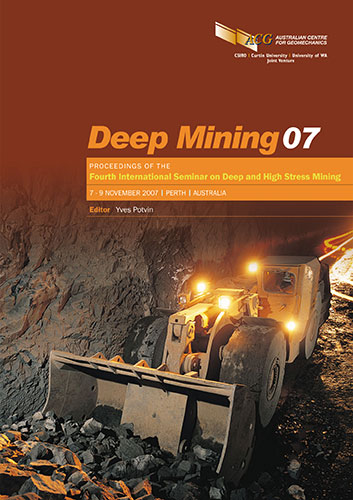The Weakest Link - Ground Support Observations at Some Canadian Shield Hard Rock Mines

|
Authors: Simser, BP |
DOI https://doi.org/10.36487/ACG_repo/711_25
Cite As:
Simser, BP 2007, 'The Weakest Link - Ground Support Observations at Some Canadian Shield Hard Rock Mines', in Y Potvin (ed.), Deep Mining 2007: Proceedings of the Fourth International Seminar on Deep and High Stress Mining, Australian Centre for Geomechanics, Perth, pp. 335-348, https://doi.org/10.36487/ACG_repo/711_25
Abstract:
The design of ground support systems is complicated by the fact that a weak link in the system can cause premature failure. Pull tests and/or dynamic test results may not be representative of how the tendon/plate/retainment system interacts with the rock mass. For example it is relatively common to see rockburst damage where the rock has shattered around the tendons, with only superficial damage to the tendons themselves. The ability of the retainment system to transfer load to the tendon elements may be critical to the ultimate success of the system, especially in bursting ground. Variable stiffness of different components can also lead to premature failure of one element prior to utilising the full capacity of another. Underground observations for both static and dynamic loading are used to discuss potential improvements and limitations of commonly used support elements (friction bolts, resin rebar, mechanically anchored rockbolts, cablebolts, weld mesh screen, plates, shotcrete). The observations are predominantly from Xstrata’s Craig Mine in Sudbury, Ontario, Canada, with some examples from other Xstrata Canadian operations. The minimum support standards at the various mines are more than adequate for most conditions. However the exceptions (where something fails) often provide more insight and the observations are focused on these cases. The mining methods are a mix of post pillar cut and fill and blasthole open stoping, utilising trackless development where tunnel size is 5 x 5 m or larger. For “static” or pseudo static loading many of the observations come from cut and fill mining where breasting through the previous cuts’ back offers an opportunity to see a cross section of both the stress induced fracturing and the previous cuts’ back support. The mines are all hard rock Canadian Shield operations where the horizontal stress is approximately double the vertical (vertical stress being predominantly due to the weight of overburden). Some rockburst damage is shown and a brief recap of some dynamic testing is given to illustrate that at least some of the support design issues can be simulated, even if the detailed response of a particular rockburst cannot be practically duplicated.
References:
Bawden, W. and Jones, S. (2002) Ground support design and performance under strong rockburst conditions. NARMS-
TAC 2002. Mining and Tunnelling Innovation and Opportunity, University of Toronto, pp. 923-931.
Blake, W. (2006) Review of Mining in High Stress Zones at Craig and Onaping Mines. Consulting report for Xstrata’s
Craig and Onaping Mines.
Davidge, G.R., Martin, T.A. and Steed, C.M. (1990) Lacing support trial at Strathcona Mine. Proceedings 2nd
International Symposium on Rockbursts and Seismicity in Mines, Minneapolis, June 1988. Balkema.
Guler, G., Kuijpers, J., Wojno, L., Milev, A. and Haile, A. (2001) Determine the effect of repeated dynamic loading on
the performance of tunnel support systems. Final Report – Safety in Mines Research Advisory Committee, South
Africa. Project No. GAP 616.
Heal, D., Hudyma, M., Langille, C., Potvin, Y., Butcher, R., Ball, R. and Hartmann, B. (2005) In situ testing of ground
support performance under strong dynamic loading. RASIM6, Controlling Seismic Risk. 6th International
Symposium on Rockburst and Seismicity in Mines, 9-11 March 2005, Perth, Australia.
Kaiser, P., McCreath, D. and Tannant, D. (1996) Canadian Rockburst Support Handbook. Geomechanics Research
Centre, Laurentian University.
Lang, T. and Bischoff, J. (1982) Stabilization of Rock Excavations Using rock Reinforcement. 23rd USRM Symposium,
pp. 935-944.
Li, T. (2001) Use of DE plates as replacement of dragonfly plates. WMC internal report for Junction Mine (kindly
provided via personnel communication).
Ground Support
Deep Mining 07, Perth, Australia 347
Mercier-Langevin, F. and Turcotte, P. (2007) Evolution of Ground Support Practices at Agnico-Eagles’ LaRonde
Division – Innovative Solutions to high-stress yielding ground. American and Canadian Rock Mechanics
Associations 1st Canada-U.S. Rock Mechanics Symposium. Vancouver, British Columbia.
Ortlepp, W.D. (2002) Dynamic Testing of Brunswick Mine Rockburst Support System. Steffen, Robertson and Kirsten
(South Africa). Consulting report for Xstarta’s Brunswick Lead/Zinc Mine.
Plouffe, M. (2006) Dynamic versus static testing of tendons. CANMET report commissioned by the Canadian Deep
Mining Research consortium.
Simser, B. (2003) Dynamic Testing of Strandlok Cables and 7/8” Rebar. Internal report Noranda Technology Centre
commissioned by Falconbridge Limited.
Simser, B., Andrieux, P., Mercier-Langevin, F., Parrott, T. and Turcotte, P. (2006) Field behaviour and failure modes of
modified conebolts at the Craig, LaRonde and Brunswick Mines in Canada. Deep and High Stress Mining.
Quebec City, Canada. October 2-4, 2006, Section 36.
Turner, M. and Green, T. (2005) Threadbar bolts in a seismically active, high stress, high yield environment – Otter-
Juan Mine, Kambalda. RASIM6, Controlling Seismic Risk, Sixth International Symposium on Rockburst and
Seismicity in Mines, 9-11 March 2005, Perth, Australia.
Villaescusa, E., (2007) Ground Support Research at the WA School of Mines. Canadian Institute of Mining, Annual
General Meeting, Montreal, Canada, 2007.
The Weakest Link ― Ground Support Observations at Some Canadian Shield Hard Rock Mines B.P. Simser
348 Deep Mining 07, Perth, Australia
© Copyright 2025, Australian Centre for Geomechanics (ACG), The University of Western Australia. All rights reserved.
View copyright/legal information
Please direct any queries or error reports to repository-acg@uwa.edu.au
View copyright/legal information
Please direct any queries or error reports to repository-acg@uwa.edu.au